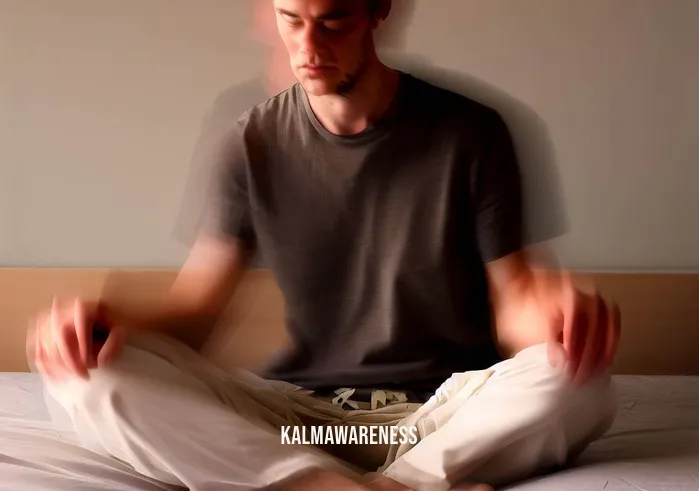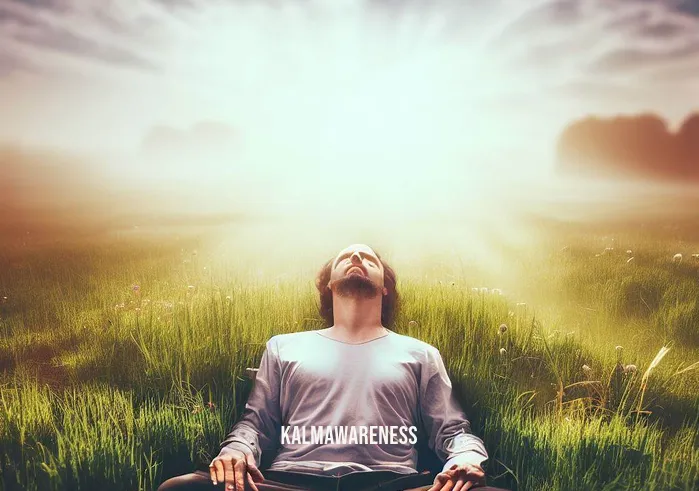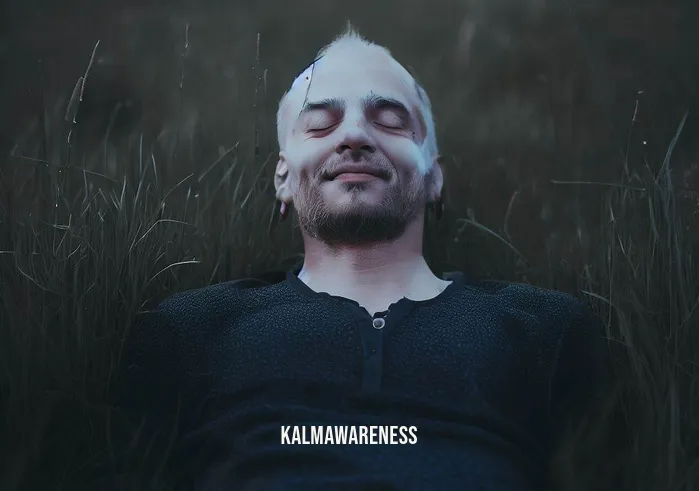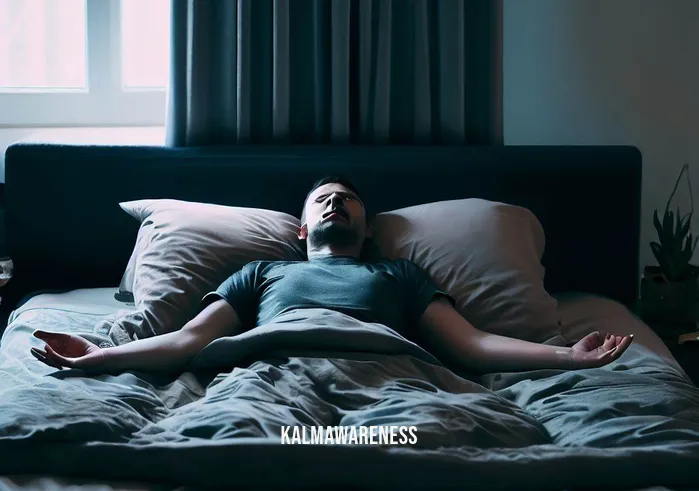Can You Meditate Laying Down: The Intersection of Rest and Mindfulness
The Relevance of Posture in Traditional Meditation
In the realm of traditional meditation practices, posture is often emphasized as a fundamental aspect. Whether it’s the lotus position in Zen Buddhism or the seated posture in Vipassana, the way one holds the body is believed to have a direct correlation with the quality of meditation. Given this importance placed on posture, one may wonder, “Can you meditate laying down?”
According to some meditation philosophies, the answer might be a cautious “no,” suggesting that a reclining position may induce sleep rather than a meditative state. However, modern mindfulness practices have a more liberal view. With the advent of different techniques like mindful movement sleep or EMDR meditation, the emphasis has shifted from strict posture to personal comfort and mental state.
Horizontal Meditation: Aligning Relaxation with Mindfulness
The concept of horizontal meditation aligns perfectly with the need for relaxation and mindfulness in today’s fast-paced world. When you meditate laying down, you’re merging two fundamental needs—rest and awareness—into a single practice. This approach is particularly useful for people who may find seated meditation uncomfortable due to physical constraints.
Moreover, horizontal meditation enables you to engage in other practices such as mindful hypnobirthing or even integrate elements of rouse yoga. Such a reclining posture is often advised for those dealing with back pain or other physical challenges that make the traditional seated or lotus position uncomfortable.
Breathing: The Core Element in Any Meditation Posture
“Breathing is the greatest pleasure in life.”
– Giovanni Papini
Regardless of your meditation position, the one element that remains crucial is breathing. Deep, conscious breathing is the element of some meditation exercises that must not be compromised, irrespective of your posture. When you focus on your breathing while meditating, it can significantly aid the process of attaining a peaceful state of mind, free of worry and distractions.
In the horizontal position, you might find it easier to notice the rise and fall of your abdomen, which can add an extra layer of awareness to your practice. Many have even experienced 256 Hz benefits when they incorporate sound meditation into their lying-down sessions, further demonstrating that the body’s orientation does not necessarily limit the potential for deep, impactful meditation.
Benefits Beyond the Mat: How Horizontal Meditation Integrates into Daily Life
Beyond the realm of formal practice, the ability to meditate in a reclining position has far-reaching implications. It allows for sustainable self-care practices that can be integrated into different aspects of daily life, from teenagers walking to school to adults taking a quick 15-minute power nap at work. This accessibility makes the practice more inclusive and encourages more people to keep mindfulness in mind—quite literally.
Moreover, horizontal meditation offers an alternative method for those who might find traditional techniques intimidating. Resources such as Jack Kornfield’s Meditation for Beginners or guides that make meditation made simple often highlight the flexibility in choosing a comfortable position, laying down included.
To Sit or Not To Sit: That Is No Longer the Question
By now, it should be clear that the answer to “Can you meditate laying down?” is a resounding “yes.” The choice of posture is secondary to the internal journey of becoming more aware and focused. The ultimate goal of meditation involves attaining a peaceful state of mind, not the perfection of a particular pose.
With all these options available, including incorporating mindful movement sleep or a quick 15-minute power nap into your routine, why limit yourself to a singular method? For those who remain skeptical or have additional questions, our exploration doesn’t end here. In the next segment, we delve into the scientific backing for horizontal meditation, as well as tips to ensure effectiveness in your lying-down practice. So continue reading to unlock the full potential of this liberating form of meditation.

The Science and Practicality of Lying-Down Meditation
The Science Behind Meditating in a Reclined Position
It’s important to delve into the scientific aspects of whether you can meditate laying down effectively. As many people are now interested in evidence-based practices, understanding the neurological and physiological implications is crucial. Researchers in the field of mindfulness have examined various postures and their impact on the brain. From these studies, it’s clear that the orientation of your body—whether sitting, standing, or lying down—doesn’t necessarily impact the quality of your meditation. The focus remains on how we get deep so fast into a meditative state.
Advantages and Disadvantages: A Comparative Analysis
To give you a well-rounded view, let’s look at a table comparing the pros and cons of meditating in a lying-down position versus the traditional seated posture.
| Criteria | Lying-Down Meditation | Seated Meditation |
|---|---|---|
| Comfort Level | High | Varies |
| Risk of Falling Asleep | Moderate | Low |
| Ease for Beginners | High | Moderate |
| Accessibility for People with Physical Limitations | High | Moderate to Low |
| Integration into Daily Routines | High | Moderate |
This table highlights that lying-down meditation is especially useful for beginners or those with physical limitations. However, the risk of falling asleep is slightly higher when lying down, making it important to approach this method with a level of judgment of the wise.
List of Techniques Suitable for Lying-Down Meditation
Several meditation techniques can be adapted for a reclining position. Here’s a list to get you started:
Body Scan Meditation: This method, closely related to touch that body part techniques, allows you to focus on different areas of your body and release tension.
Guided Imagery: This technique can be very effective when lying down, as your body is already in a relaxed state.
Breathing Exercises: As discussed earlier, breathing is crucial in any form of meditation. Here, you can focus on various breathing techniques.
Sound Meditation: The lying-down position is conducive to absorbing the auditory sensations, providing an experience that can bring significant 256 Hz benefits.
Mindfulness: While seated mindfulness practices are common, lying down provides an alternative that some people find more comfortable and effective.
Incorporating Lying-Down Meditation into Daily Rituals
Given its versatility, lying-down meditation is incredibly adaptable to daily routines. You can incorporate it into a 15-minute power nap or even during teenagers walking to school as a means of encouraging mindfulness from an early age. Moreover, such techniques can serve as a reliable tool for sustainable self-care, whether you are a busy professional, a parent, or a student.
Taking Meditation Off the Cushion: The Wider Implications
The implications of the practice go beyond answering the question, “Can you meditate laying down?” to redefine what meditation can look like for people in various life circumstances. By offering an alternative to traditional seated methods, it brings mindfulness into a more accessible and inclusive realm. One can incorporate such practices into daily life, from mindfulness during a walk, as outlined in the guide to teenagers walking, to finding serenity in a simple 15-minute power nap.
While we’ve addressed the scientific backing and practical aspects of meditating in a reclined position, many questions might still be lingering. Perhaps you’re wondering how to integrate lying-down meditation with other relaxation techniques or how to avoid common pitfalls like falling asleep. In the next chapter, we’ll explore how to maximize the effectiveness of your lying-down meditation practice, along with useful tips and tricks. So continue reading to elevate your meditation journey to the next level.

The Healing Power of Reclined Meditation: Stories of Hope and Inspiration
A Symphony of Hope: Real-world Examples
Just as it’s crucial to understand the science and practicality of meditating while lying down, the personal stories and anecdotes bring the practice to life. Countless individuals have found hope and solace through laying down meditation, and their experiences serve as an affirmation of its value. Particularly for people who have limited mobility or are dealing with chronic pain, this form of meditation becomes a beacon of hope. They can still attain a peaceful state of mind in which thoughts are not occupied by worry, making this practice an essential tool in their sustainable self-care toolkit.
“The quieter you become, the more you can hear.”
– Ram Dass
The above quote reminds us that sometimes, quiet moments offer the most profound insights. And what better way to embrace quietude than through a laying-down meditation? For many, it has been a form of mindful hypnobirthing to alleviate labor pain or as a complimentary therapy for EMDR (Eye Movement Desensitization and Reprocessing) in EMDR meditation.
The Role of Laying Down Meditation in Therapeutic Settings
“In stillness, the world resets.”
– Unknown
For those undergoing psychotherapy or engaged in mindfulness-based stress reduction, lying-down meditation has found a functional role. As the quote suggests, stillness can serve as a reset button for our cluttered minds. Therapists and counselors often encourage this method as an element of some meditation exercises to help people better manage stress, anxiety, and even insomnia. Lying down meditation doesn’t just provide physical comfort; it acts as a salve for the restless mind.
From Skepticism to Faith: The Journey of Reclining Meditation
“Faith is taking the first step even when you don’t see the whole staircase.”
– Martin Luther King Jr.
When it comes to adopting a new practice like reclining meditation, it’s natural to be skeptical. You may wonder if laying down would indeed allow you to be mindful or if you would just doze off pretty soon. But that’s where faith comes in. Take that first step, and you’ll often find that lying down doesn’t mean slacking off. It means opening yourself up to a different yet effective form of mindfulness.
So, if you’ve been postponing your meditation practice because sitting for extended periods isn’t feasible for you, don’t wait any longer. There’s a reason why you hear so often to “keep in mind” the importance of mindfulness practices like this. Its significance is much more than what meets the eye and incorporates a deep-seated, psychological stabilization that comes with regular practice—indeed a spell that helps to stabilize both your mind and body.
What Lies Ahead: A Teaser for the Next Chapter
After covering the scientific aspects, practical applications, and the inspiring stories related to laying down meditation, it’s time to look ahead. The next chapter will serve as a comprehensive guide to help you integrate this unique form of mindfulness into your daily life seamlessly. From morning rituals to bedtime routines, we will explore different ways you can make reclining meditation a part of your everyday life, just like one for each blessed day.
So continue reading, and let’s embark on this journey towards holistic wellness and peace of mind. The best is yet to come.

The A to Z of Lying Down Meditation: Unpacking the Practice
The Anatomy of Lying Down Meditation
We’ve covered the scientific reasoning, practical applications, and inspiring stories behind reclined meditation. But the question that perhaps still lingers is: What exactly is involved in the practice of meditating while lying down? After all, being horizontal is often associated with sleep or rest, rather than meditation. In this chapter, we’ll break it down for you.
Important Components
Breathing: This is crucial. Whether you’re sitting, standing, or lying down, the essence of meditation revolves around breathing. The advantage of lying down is that you’re not fighting against gravity; your breathing can be more relaxed, paving the way for a deep state of mindfulness.
Awareness: Just as in other forms of meditation, maintaining awareness is key. When you’re lying down, you have the freedom to focus on different parts of your body in a way that’s physically less stressful than other positions.
Positioning: While lying down offers comfort, it’s crucial to find a posture that doesn’t strain any part of your body. The aim is to maintain a state of comfort while avoiding the urge to sleep, making the practice quite effective for those wanting to take a 15-minute power nap that revitalizes the mind.
Different Scenarios Where Lying Down Meditation is Useful
As you might imagine, the flexibility of reclining meditation makes it valuable in various situations. Here are a few:
Pre-Sleep Routine: Incorporating a lying-down meditation routine can prepare the mind for a restful night of sleep.
Chronic Pain Relief: For those who experience pain during seated or standing meditation, lying down becomes an attractive alternative.
Teenagers: Given the restless lives many teenagers lead, it’s no surprise that practices like teenagers walking meditation are gaining popularity. Lying down meditation can also be a beneficial addition to their mindfulness routine.
Steps to Implement Lying Down Meditation
Select a Comfortable Surface: Not too hard, not too soft. The surface should support your body weight without causing strain.
Lay Flat: Use a pillow if necessary, especially to support the head and neck.
Start with Deep Breathing: The principle here is similar to Rouse Yoga, where breathing is emphasized as a foundation for all other movements.
Engage in Mindful Movement: While lying down limits your physical movements, this constraint can actually make your meditation practice more focused. Consider adopting techniques from Mindful Movement Sleep practices.
End with Gratitude: Before rising, take a moment to express gratitude for the time you’ve set aside for yourself.
The Next Horizon: Anticipation for the Final Chapter
We’ve gone deep into understanding the logistics and nuances of lying down meditation, making it easier than ever to integrate this practice into your life. However, our journey doesn’t end here. In the final chapter, we’ll wrap everything up by providing a structured plan to implement lying down meditation as a consistent practice. Expect tips that are backed by the judgement of the wise in the field of mindfulness and mental well-being.
As you proceed to the concluding chapter, keep in mind that this practice is much more than a trend; it’s a lifestyle choice that offers manifold benefits. Ready to dive into making it a permanent fixture in your life? The next chapter holds the keys. Stay tuned!

Reclining Into Enlightenment: The Journey and The Takeaway
A Refreshing Outlook on Horizontal Meditation
It’s been a delightful journey exploring the question many of us had: “Can you meditate laying down?” Not only did we discover that it’s entirely possible, but we also dove into the science, the practices, the cultural norms, and even the specific scenarios where reclining can enhance the overall experience of mindfulness.
What We Learned
From teenagers battling the angst of growing up, to busy professionals yearning for a sustainable self-care routine, lying down meditation can be a game-changer. We found out that this form of meditation involves attaining a peaceful state of mind in which thoughts are not occupied by worry, which is beneficial for all age groups. We also discussed the elements that make lying down meditation unique, such as the relaxed state it naturally induces and the different contexts in which it is particularly useful.
Summing It Up: The Joy of Restful Mindfulness
As we close this chapter, let’s remember that horizontal meditation isn’t a lesser form of mindfulness; it’s a nuanced approach that complements other forms of relaxation and mental stability. The posture allows for a more direct connection with the element of some meditation exercises that involve focusing your energy inward. It’s more than just a practice; it’s a conscious choice that fosters a harmonious balance between the mind and body, making meditation simple for everyone, as elaborated in Meditation Made Simple.
A Call-to-Action: Ignite Your Journey
Why not take the plunge? Revisit our previous chapters to refresh your memory, or better yet, lie down and experience the tranquility for yourself. Our magazine is brimming with enriching content that can aid you in this practice and beyond. And remember, it’s not how you spell “stabilize” your mind, but how you actually stabilize it that matters.
A Heartfelt Thank You!
We can’t thank you enough for taking the time to journey through the captivating world of lying down meditation with us. With mindfulness practices like these, every day can be a blessed day.
Stay tuned to our future editions, where we’ll bring you more insights, more stories, and more tips to help you lead a more balanced and harmonious life.
Now, why not take this new-found knowledge and integrate it into your life? After all, it could be the start of something wonderfully serene. Happy Meditating! 🙏




